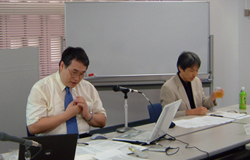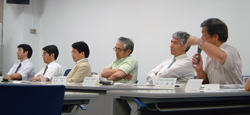Center for Interdisciplinary Study of Monotheistic Religions(CISMOR)Doshisha University
> Archives > 21st Century COE Program Archive > Research Groups > Research Group1 > 2005-0221st Century COE Program Archive
2005-02
| Date: | July 23, 2005 |
|---|---|
| Location: | Tokyo Office, Doshisha University |
| Title: | A Typology of the Christian World From the Viewpoint of the Comparative Study of Civilizations |
| Speaker: | Takashi Kato (Professor, Faculty of Letters, Chiba University) |
| Title: | The Possibility of Canonical Interpretation: the Canon as a Jar of Clay |
| Speaker: | Ritsu Ishikawa ( Professor, School of Theology, Doshisha University) |
| Summary: | |
| In this seminar meeting, Dr. Kato analyzed the structure of Christian world with a typological viewpoint, and Dr. Ishikawa dealt with the Biblical canonics. Dr. Kato observed the multilayer structure in the Western Christian world. At first the Western world was the two-layer structure of a free man and a slave. At the period of Alexander the Great, lower layer people increased in number, and the upper levels have forced labor for management of these people. In result, a free man lost his freedom and society became unstable. Enacted Christianity as a state religion by Roman Empire brought stability to this situation. There was two-layer structure in Christianity of a clergyman and a believer. This was also Gospel writer Luke's problem already. Dr. Kato analyzed it appears in the parable of good Samaritan and the tale of Maria and Malta. With the Church established, social structure changed to the three-layer of a clergyman, an aristocrat, and the mass. This structure brought about medieval stability and prepared scientific development. At the period of enlightenment and the French Revolution, this structure had changed. By having deprived the clergyman of authority, society shifted to two-layer structure again. The connection with divinity which clergyman had replaced with the natural reason recognizes the providence of God, two-layer structure turns into contrast in the Western world (enlightened) and the barbarous (uncivilized). The wealth, which continues increasing by scientific development brought social stability. It extended to lower layer and reduced that sphere, thereby large-scale secularization was urged. Dr. Kato said that this was in the recent situation. It seems that religious value was lost here, however he said it was not correct. He exemplified his opinion with arguing the worship of "highest existence" in the period of the French Revolution. The "highest existence" is expressed as the symbol of an eye and many religions is subordinated to this eye in the pictures describing Napoleon's Concordat proclamation in it. Moreover, this eye is drawn also on the back of one-dollar bill. Dr. Kato suggested study this "highest existence faith", which can be said also as enlightenment-religion and have monotheistic structure. At the beginning of lecture, Dr. Ishikawa stated his standpoint as one Christian's, not researcher’s. It is written to the confession of the United Church of Christ in Japan (U.C.C.J.) as follows: "the Holy Bible is the Word of God which gives us full knowledge of God and salvation, and is the unerring standard of faith and life." In view of present situation of a church, it is not caught such. As a reason the Canon lost its authority, he points out the development of historical-critical Biblical studies based on enlightenment. Especially, the methods of form criticism and tradition criticism in NT studies eliminate faith and theology from research. These methods tend to rationalize and historicize the Bible to understand. Thereby severe criticism will be thrust to the Bible as the Canon (especially NT). The Bible cannot be caught with canon any longer from the viewpoint of these studies, or rather for them the concept of the Canon does not have significance primarily. However, the Bible is not the thing of only academic researchers. Dr. Ishikawa said that primary scene of Bible is a church as a gathering of those who read the Bible simply in quest of salvation, and for such a church needs the Canon. To recite and mediate, in order to succession of faith, as a Sumo ring of an discussion, the Canon is required. Rather, the unique semantic space, which historical-critical researches cannot comprehend, appears by the Bible being offered as one book. This is also the matter found out in the research of Psalm, which started by Fueglister. However, this is not restricted to the Psalm studies. It is important in the whole Bible to catch sound in a symphony as E. Zenger pointed out. In response, Dr. Ishikawa compared the Canon to earthenware. It was built artificially and is weak. However, if this was broken, both the testimony and truth that were stored there would also lose. K. Barth wrote Church Dogmatics, Dr. Ishikawa said that not the Biblical studies based on enlightenment but things should say also by Church Biblical Theology is required for present church to the last. Dr. Nakamura commented after that that two-layer structure could be pointed out as the main point, which leads to both announcements. The two-layer structure of modern society which Dr. Kato points out, and the structure of biblical studies based on enlightenment and a church which Dr. Ishikawa points out were in agreement exactly. Continuously, Dr. Echigoya made the point that Dr. Ishikawa's viewpoint was the position attaches too much importance to final edition, thereto he threw the doubt with mentioned the view of J.Barr etc. The discussion was variously developed also even for after the above comment involving right of interpretation of the Canon, the problem of two-layer structure, the problem of a Bible interpretation, etc. Tai Takata (COE Promoted Researcher, Graduate Student of School of Theology, Doshisha University) |
|

